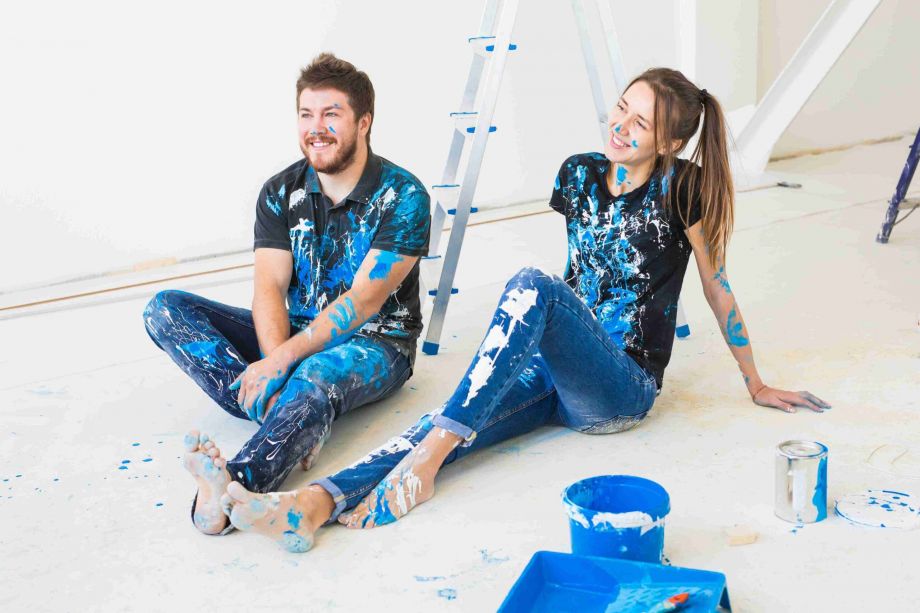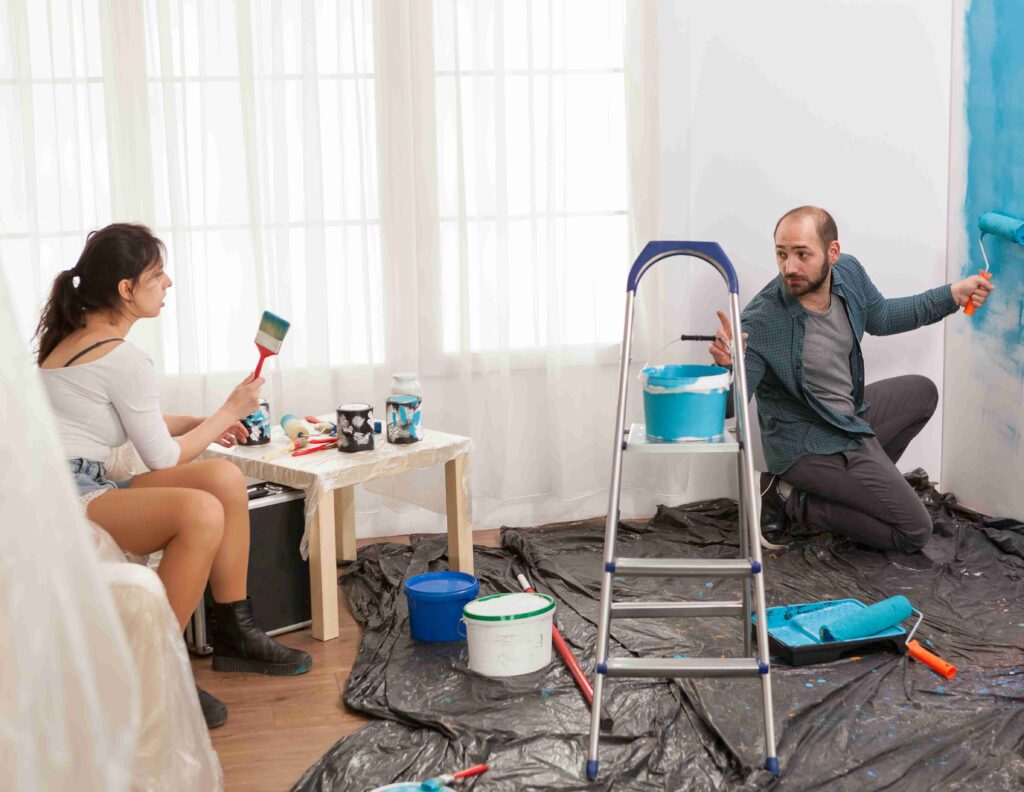
Can You Paint Eggshell Over Flat? (Guide)
Flat paint is fine… until it’s not. At first, that soft, matte look feels modern and cozy.
But then the fingerprints start showing. The scuffs multiply. And suddenly, you’re eyeing a can of eggshell paint, dreaming about a finish that’s still pretty but way easier to clean.
Good news: you can totally make the switch without a massive renovation.
Painting eggshell over flat is not only doable, it’s actually one of the easier upgrades you can tackle in a weekend.
In this post, we’ll show you exactly how to paint eggshell over flat, so you get a smooth, long-lasting finish that looks like a pro handled it.
Can You Paint Eggshell Over Flat?
Yep, you can paint eggshell over flat.
Eggshell paint is a solid choice because it sits right between flat and satin.
It gives you just enough sheen to reflect light and brighten a room, but it’s not so shiny that it shows every little wall imperfection.
And once it’s on, you can wipe it down without worrying about ruining the finish.
Flat paint has a slightly rough, matte texture, which means new paint clings to it really well. That’s the opposite of painting over something glossy, where the new coat might slide right off if you skip sanding.
But you need to get the walls clean and free from dust or oils so the eggshell can bond properly.
If you want the best results, a quick prime in certain situations can help too.

Also Read: Can You Paint Over Gel Stain?
Why Flat Paint Makes A Good Base
Flat paint is kind of like a sponge. It’s porous, so it grabs onto whatever you put on top. That’s great for adhesion but also why flat paint tends to stain easily – it absorbs things.
That same porosity works in your favor here.
Instead of worrying about sanding down a glossy surface, you can pretty much start with cleaning and patching.
Another bonus: flat paint usually hides small wall imperfections better than glossy finishes, so when you add eggshell, you still get a forgiving surface.
The only times you might want to prime first are:
- When you’re covering a dark wall with a much lighter color.
- When the wall has stains, water marks, or smoke damage.
- When you want extra insurance for durability in high-traffic areas.
If none of those apply, you can usually go straight to painting after your prep work.
How To Paint Eggshell Over Flat
Painting eggshell over flat is straightforward, but the difference between a patchy, streaky job and a pro-looking finish comes down to how much care you put into each step.
Also Read: Can You Skim Coat Over Wallpaper?
Here’s quick guide on how to do it like a pro:
#1. Gather Tools And Supplies
Before you dive in, get everything ready. You’ll want:
- Eggshell paint in your chosen color
- Paint roller and roller covers (medium nap for walls)
- Angled brush for cutting in edges
- Painter’s tape
- Drop cloths or old sheets
- Mild soap or wall cleaner
- Sanding sponge or fine-grit sandpaper
- Primer (if needed)
Having it all on hand means you won’t have to stop halfway through because you forgot a brush or ran out of tape.
#2. Clean The Walls
Paint sticks best to clean surfaces. Dust and oils can mess with adhesion, even on flat paint.
Use a damp sponge with a bit of mild soap to wipe down the walls, especially around light switches, doors, and areas where hands touch often.
If the walls are really dirty, you might need a stronger cleaner like TSP (trisodium phosphate), but for most homes, a gentle wipe will do.
Just make sure the walls are dry before you move on
#3. Prepare The Surface
Flat paint hides a lot, but eggshell has a soft sheen that can show imperfections you never noticed before. This is the moment to deal with them.
Walk the room and mark any nail holes, dents, or cracks with painter’s tape so you don’t forget them.
Fill holes with spackles and smooth them out.
Once dry, sand the patched spots until they’re flush with the wall.
If the whole wall feels a bit rough, a quick once-over with a fine-grit sanding sponge will help the new paint glide on like butter. Wipe away any sanding dust before moving forward.
#4. Apply A Primer (Recommended)
Primer isn’t always mandatory here, but it can make a big difference. It creates a smooth, even base so your eggshell paint goes on flawlessly and the color looks richer.

This is especially important if you’re making a big color change, like covering deep navy with pale beige or dealing with stains or uneven wall tones.
Use a roller for the large sections and a brush for edges and corners.
Don’t rush it; let the primer dry fully before you even think about picking up your eggshell paint.
This waiting step feels boring but pays off in the final look.
Also Read: Do You Prime Before Texture?
#5. Apply The Eggshell Paint
Start by “cutting in” with your angled brush and paint around edges, trim, and corners where the roller won’t fit. This helps you keep clean lines and prevents missing spots later.
Load your roller with paint, but not so much that it’s dripping.
Roll in a “W” or “M” shape to spread the paint evenly, then fill in the gaps with smooth, light strokes. Work in sections so the edges stay wet and blend together seamlessly.
And resist the urge to go back over drying spots as it’s a fast track to streaks.
#6. Add A Second Coat If Needed
Sometimes one coat is enough, especially if your colors are similar.
But if you can see the old color peeking through, or the finish looks uneven, a second coat will pull everything together.
Make sure the first coat is completely dry before you start the second!
Apply it just like the first: edges first, then smooth roller strokes across the wall. That extra layer gives you richer color, better coverage, and a finish that’s built to last.
Common Mistakes To Avoid
Painting eggshell paint over flat isn’t rocket science, but there are a few traps that can make the job harder than it needs to be.
Skipping prep is the biggest one. Dirty walls, unfilled holes, or rough patches will show more with eggshell than they did with flat.
Another mistake? Using cheap brushes or rollers.
They can shed bristles or leave lint in your finish.
Some people also overload their roller with paint, which causes drips and heavy lines. And then there’s the temptation to paint in one super-thick coat to “save time.”
Also Read: How To Choose A Painting Contractor In Virginia
That usually leads to uneven drying and streaks. Two thinner coats almost always look better.
And don’t paint in extreme heat or humidity. Humidity slows drying and can mess with how the sheen settles. Heat can make paint dry before you’ve had a chance to blend it properly.
Bottom Line
Painting eggshell over flat is one of the easier wall upgrades you can do.
Flat paint’s texture works in your favor, and with the right prep, you’ll end up with a smooth, durable finish that brightens your space and stands up to daily life.
It’s a simple weekend project – clean, patch, maybe prime, then roll on that fresh eggshell coat.
You don’t need fancy skills, just patience and the right tools. Once it’s done, you’ll wonder why you didn’t swap out that flat finish sooner.







